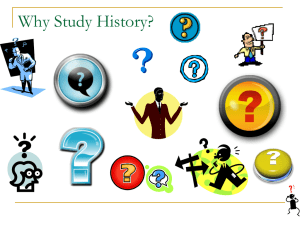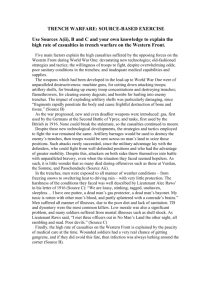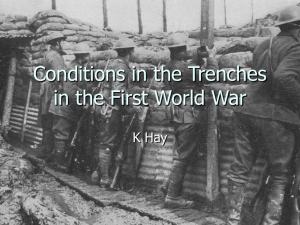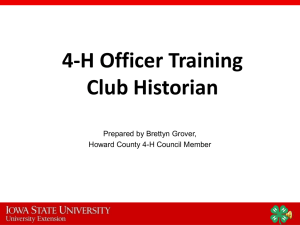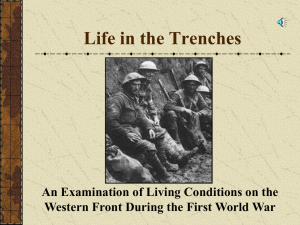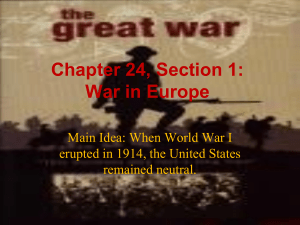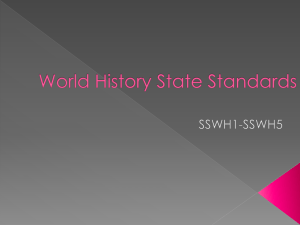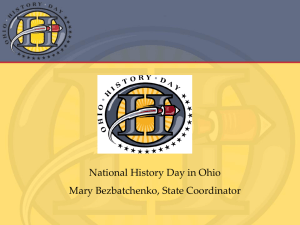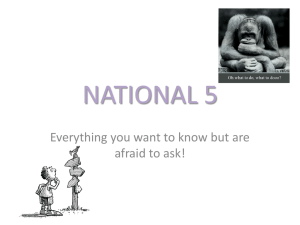(Answering WWI Questions) right
advertisement
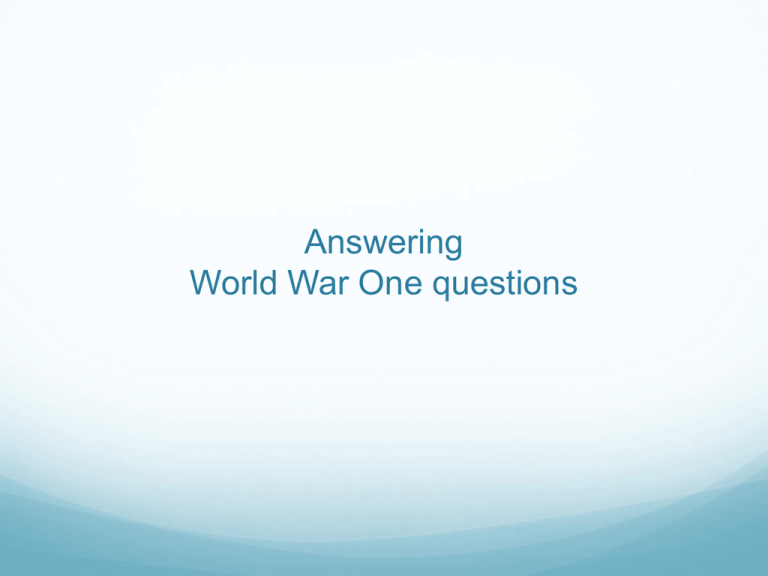
Answering World War One questions World War One Questions Part A (15 marks) Multiple Choice Short Answer Part B (10 marks) Source Analysis Multiple Choice Questions Read the “stem” of the question Read all the options Beware of options that are factually true but do not provide a correct answer to the “stem” Look for the most correct response Practise all the past Multiple Choice questions using the slideshow on our intranet Short Answer Questions Must use some content from both sources Must use more content from own knowledge Must answer the question - content must be relevant to the question Marks vary from 3 to 6. (2 - 3 lines per mark) Your best preparation? Practise Question 2 from all pre-2010 papers. Aim to complete your response in maximum of 18 lines. Short Answer Questions - The Pattern Refer to sources as “Source A” and “Source B” etc. In one or two sentences, refer to information in both sources and explain how this helps answer the question In remaining sentences include as much relevant own knowledge as possible that helps answer the question Try to include own knowledge that will dazzle your marker – like the examples that follow The Pattern in practice - 1 2010 HSC - a very short answer question Source C Photograph of French soldiers in a communications trench near Verdun Question Use your own knowledge and Source C to give three reasons why it was so difficult to evacuate wounded men from the trenches. (3 marks - six lines provided) The poilu in Source C had to navigate extremely narrow trenches and avoid the other casualties as they sought to extricate the wounded. In addition, mud in the trenches, especially at Passchendaele in 1917, and the continual risk of artillery fire, frequently targeted at communications trenches, added to the difficulties stretcher bearers would face. The Pattern in practice - 2 2009 Specimen HSC - a regular short answer question Source A From History of the Great War Based on Official Documents, London, 1932. Causes of British Casualties 1914-1918 Shell or mortar fire Rifle and machine gun bullets Bombs and grenades Bayonet 58.5% 39.0% 2.2% 0.3% 100.0% Source B Extract from a letter by Paul Nash, a soldier and official war artist on the Western Front, November 1917. The rain drives on, the stinking mud becomes more evilly yellow, the shell holes fill up with green-white water, the roads and tracks are covered in inches of slime, the black dying trees ooze and sweat and the shells never cease. They alone plunge overhead, tearing away the rotting tree stumps, breaking the plank roads, striking down horses and mules, annihilating, maiming, maddening, they plunge into the grave which is this land; one huge grave, and cast up on it the poor dead. Question Briefly outline the impact of artillery on the conduct of war on the Western Front. Use your own knowledge and Sources A and B to answer this question. (4 marks - ten lines provided) Source A clearly shows the destructive power of artillery on soldiers, accounting for 58.5% of all British casualties and Source B shows the impact of shells on the landscape, especially prone to this damage because it was so flat, especially in Flanders where drainage systems were easily ruined. Massive shelling of Verdun by the Germans in early 1916 and the Somme by the British before their July offensive of that year was extraordinarily destructive, making frontal assaults even more difficult. Improved artillery and shells enabled innovative tactics, including the creeping barrage, that had a real impact on the conduct and outcome of the war. Source B The Pattern in practice - 3 Extract from a letter by British soldier Robert Graves to a friend, May 1915. May 28th. In trenches among the Cuinchy brick-stacks. Not my idea of trenches. There has been a lot of fighting hereabouts. The trenches have made themselves rather than been made, and run inconsequently in and out of the big thirty-foot high stacks of bricks; it is most confusing. The parapet of a trench which we don't occupy is built up with ammunition boxes and corpses. Everything here is wet and smelly. The Germans are very close: they have half the brick-stacks, we have the other half. Each side snipes down from the top of its brick-stacks into the other's trenches. This is also a great place for German rifle-grenades and trench-mortars. We can't reply properly; we have only a meagre supply of rifle-grenades and nothing to equal the German sausage mortar-bomb. This morning about breakfast time, just as I came out of my dug-out, a rifle-grenade landed within six feet of me. For some reason, instead of falling on its head and exploding, it landed with its stick in the wet clay and stood there looking at me. They are difficult to see coming; they are shot from a rifle, with its butt on the ground, tilted, and go up a long way before turning over and coming down head first. Source D Extract from John Laffin, The Western Front Illustrated 1914-1918, Sydney, 1993. The degree of discomfort depended on the season, the weather and the extent to which trenches were smashed by enemy guns. Some periods and some sectors were appalling. For instance, in the winter of 1916-1917, on the Somme front, there were no 'proper' trenches, only weather-eroded muddy ditches. Officers and men realised that there was no point in improving the trenches because the mud would collapse them or within hours enemy guns would smash them. Some trenches had no barbed-wire cover because the soldiers of both sides were incapable of moving, let alone erecting wire. Wet through from constant drizzle, freezing cold and desperate for a hot meal, the miserable men huddled under whatever shelter they could scratch together. Soldiering was just a matter of enduring until the relief unit arrived. Should an attack have been contemplated, the slime prevented the men from climbing out of the trenches. So did the absence of wooden ladders, which the frozen men burned in an attempt to keep warm. Duckboards, burial crosses and even the hard-issue biscuits were used for the same purpose. 2010 HSC - a longer short answer question Question Use your own knowledge and Sources B and D to answer this question. Outline how the experiences of trench warfare changed soldiers’ attitudes to the war over time (6 marks - eighteen lines provided) Source B highlights the appalling conditions the men faced with trench parapets “built up with … corpses” and the lack of supplies that plagued British troops, especially in 1915 with the shell crisis that led to the creation of a Ministry of Munitions led by Lloyd George. Such conditions, nine months into a war that was supposed to be “over by Christmas”, was destined to sap morale and generate negative attitudes from the soldiers.The continuing discomfort is highlighted in Source D with rain turning battlefields into quagmires of mud, made worse by enemy artillery. The Somme battle of 1916 saw the British fire 100,000 shells per day for seven days before the offensive yet in spite of this the Allies suffered 50000 casualties on the first day. One can imagine that such catastrophic losses would have further eroded morale and soldiers’ attitudes to the war. 200,000 casualties in the first ten days of the Nivelle Offensive of April 1917 provoked widespread mutinies in the French Army. Later in 1917, the debacle of Passchendaele, with men and horses drowning in mud, generated deep pessimism which counterpointed the optimistic attitude so evident in the early weeks of the war. The Source Analysis Question What does the syllabus say you are supposed to be able to do? OUTCOMES: STUDENTS ‘analyse and evaluate sources for their usefulness and reliability’ ‘explain and evaluate differing perspectives and interpretations of the past’ STUDENTS LEARN TO ‘evaluate the usefulness, reliability and perspectives of sources’ ‘account for and assess differing historical interpretations of World War I’ What might sources be? Map, or statistical table – from contemporary text Document (e. g. letter) – speech, newspaper article, minutes of meeting, proclamation, law from the period Image – photograph, cartoon from the period Poster – from the period – primary source Memoir (autobiography) – published primary source Contemporary historian’s view – secondary source What should we consider as we try to evaluate a source? Type? Poster, letter, speech, proclamation, memoir Author? Perspective – player? Stake? Motive? Self-justification? Proximity – central or peripheral? Class, position, outlook? Partisanship? Date? Context? At the time of events, or at a distance? Intervening events? Climate of opinion? Audience? Its assumptions? Prevailing consensus? Style? Choice of words, ‘loaded words’, tone - suggesting partisanship, prejudice, fixed ideology? Opinion or fact? What is the balance? Degree of detail and verifiability of facts? Sources given? Opinions logical, consistent or illogical, employing false dilemmas and non sequiturs? Selectivity? Relatively complete perspective? Or obvious gaps? Ignores inconvenient facts? Purpose? From all of the above, why was the source written or produced? A chiefly informative or persuasive purpose? Therefore, how RELIABLE is it? What PERSPECTIVE does it offer? The Source Analysis Question - The Pattern Two paragraphs - one for each source. Do not do an integrated coverage. Do each source separately. Cover both sources equally. Start with a one sentence answer on “how useful” and give some brief indication of why you have made your judgement. Continue with an analysis of “perspective”. Make and argue a judgement on “reliability”. Conclude with a link to the question. About twenty-two lines are provided for each source. Use a little more if you need it but stay within “scan marks”. Ask for a new writing booklet if you need it. The Source Analysis Question “perspective” After your one sentence answer, explain the “perspective” of the source. In doing so, you might consider: • When was it created? - During the war? Soon after the war? Years after the war? - Costs/Benefits of proximity? Costs/Benefits of Hindsight? • Where was it created? - Britain? Germany? A non-combatant nation? At the front? Home front? • Who created it? - Soldier? Officer? Civilian? Historian? Politician? Eye-witness? Gender? - Power/Authority? Partial or impartial? Social class? Detached observer? - Political positioning? Left or right wing? Pro-war? Anti-war? The Source Analysis Question “reliability” In the second half of your response, judge the “reliability” of the source. In doing so, you might consider: - Purpose/Motive - to inform, to persuade, to assess, to inspire, to create fear - Audience - soldiers, civilians, generals, politicians, nationality, narrow, wide - Factual content - Detailed? Accurate? Wide-ranging? Limited? Truthful? - Verifiability - acknowledgement of sources? - Supporting evidence? - Costs/Benefits of proximity? Costs/Benefits of Hindsight? - Objective or Subjective? Impartial or Partisan? - Tone - Loaded words? Emotional or Unemotional? Biased or Unbiased? - Underlying ideology? - Internal consistency? Any of these can be helpful in your argument about the degree of reliability. Remember, even if a source may have some questions about its reliability it can still be useful for … something. We just have to say “useful for ...” The Source Analysis Question The pattern in practice - 1 Source E Extract from a letter by Charles Seymour, member of the US delegation at the Paris Peace Conference, 11 June 1919. ... The attitude of the different governments remains unchanged from last week and it seems very questionable whether they can reach an agreement during the next four or five days. Lloyd George is still insisting on radical changes and concessions to the Germans. Wilson has agreed that so far as economic terms are concerned, it would be most desirable to have a fixed indemnity* set; but in this respect the French are holding out, fearing that the amount of the indemnity which seems large to us now would seem very small in a few years. * indemnity = reparations Question How useful would Sources E and F be for a historian studying the different goals of Clemenceau, Lloyd George and Wilson in creating the Treaty of Versailles? In your answer, consider the perspectives provided by the TWO sources and the reliability of each one. (10 marks - forty four lines provided - twenty two per source) The perspective of an American insider at the Paris Peace Conference gives Source E a high degree of usefulness for a historian. As a member of the US delegation, Seymour offers an insight of the behind-the-scenes negotiations that led to the creation of the terms of peace. His privileged position as an observer at the private negotiations at the Quai d’Orsay in early 1919 offers the historian a remarkable insight into the motivations of the “Big Three” and their conflicting aims. He articulates an American viewpoint, indicating that Wilson wanted fixed reparation payments but reveals that Clemenceau sought a larger sum to punish the Germans. He also claims that Lloyd George, by contrast, sought significant concessions to the Germans. Clearly the goals of the Allied leaders were so divergent that Seymour doubted an agreement was in imminent prospect. Not only is the content of this source revealing for the historians, but it can also be judged to be highly reliable. Though Seymour was a minor figure, he seems acutely aware of the attitudes of all the major participants and reports these differences with apparent honesty and impartiality to what seems a narrow but unidentified audience. His loyalty to Wilson does not seem to prejudice his account of these differences. The apparent impartiality of Seymour’s letter and the insider’s perspective it affords makes this a source of great utility to a historian of the “Big Three”. The Source Analysis Question The pattern in practice - 2 Source E Extract from The Truth About the Peace Treaties by David Lloyd George, British Prime Minister 19161922, published in 1938. Clemenceau and Orlando, Premier of Italy, also had their difficulties with the public opinion of their respective countries. The pressure in their case, exactly as in mine, came from the extremists who insisted upon extracting out of the victory, advantages which were in contravention of* the fundamental principles of the peace terms formulated by the Allies. The two issues which created the greatest trouble between France, on the one hand, and Britain and the United States of America on the other, were the fixation of the Western boundaries of Germany (this included the highly controverted** questions of the Rhine frontier and the future destiny of the Saar coalfields); and the extortionate*** demand put forward by French Ministers for reparations from Germany. * in contravention of: against ** controverted: controversial *** extortionate: unreasonably large Question How useful would Sources E and F be for a historian studying the different goals of Clemenceau, Lloyd George and Wilson in creating the Treaty of Versailles? In your answer, consider the perspectives provided by the TWO sources and the reliability of each one. (10 marks - forty four lines provided - twenty two per source) Source E would be a valuable source for a historian, though less so than Source E as Lloyd George’s motives raise questions as to its reliability.It is written by David Lloyd George, wartime Prime Minister from 1916 and Britain’s chief negotiator in Paris in 1919, but it is published in 1938 when Germany was again threatening war and the folly of Versailles would have been arrestingly apparent.The perspective of a major conference participant would have obvious appeal to a historian but as a memoir published nearly a generation after 1919, a historian would be sceptical of the author’s motive. The content of the source is useful for a historian as it clearly identifies the pressures right wing extremists placed on “LG” and Clemenceau. It also nominates the specific issues that divided France from the English-speaking powers - borders and reparations. The motive of “LG” certainly raises doubt about the reliability of this source. By 1938, with the Versailles settlement in tatters, “LG” appears to be defending or justifying his role and blaming other factors and participants for the problems that would, by 1938, have become evident. An astute historian would factor this into assessments of the source’s reliability but it would nevertheless be useful for a historian as it articulates the opinions of a key player who, with the advantage of hindsight, can reflect on the contending goals of the “Big Three” and Versailles Treaty they authored.
